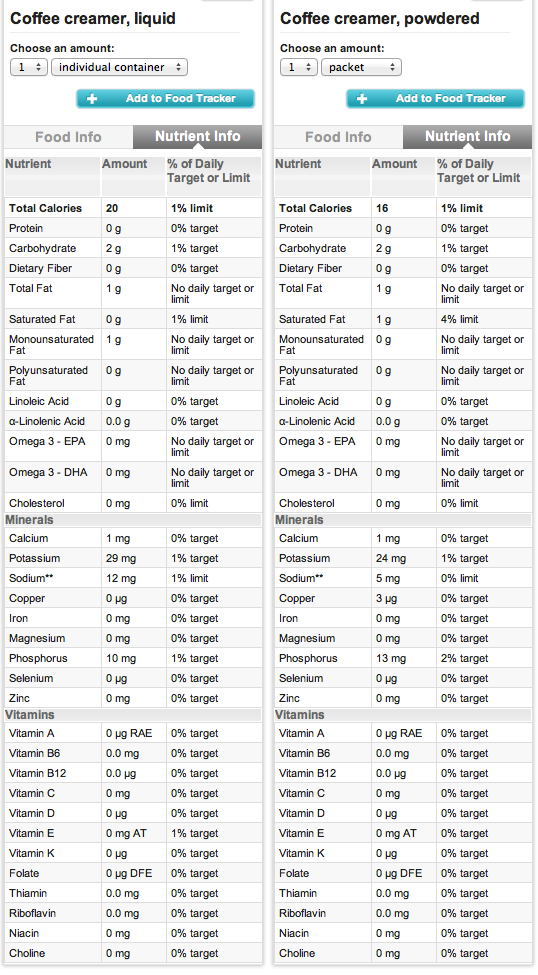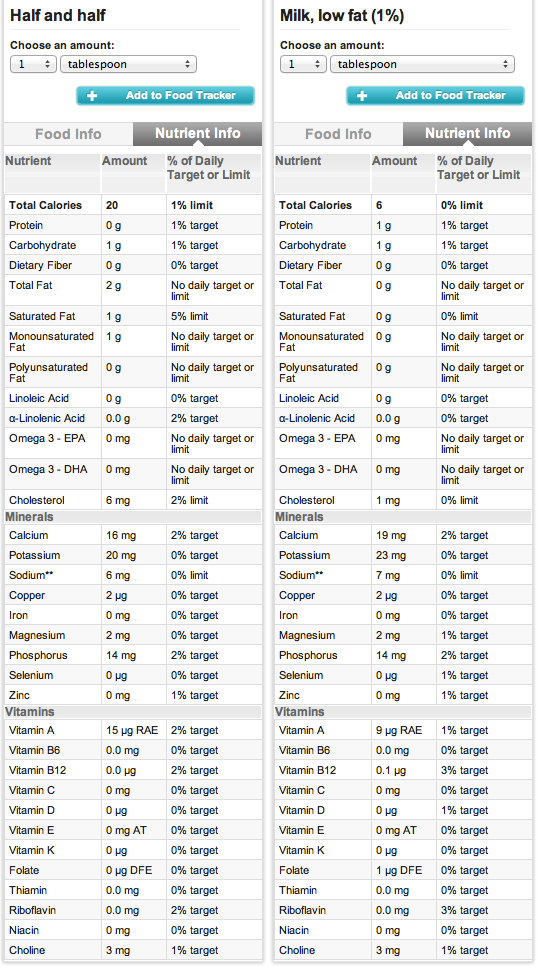We got a great question from Facebook about which is better to use in coffee, half and half or non-dairy creamer. I think this is a great topic to discuss because by itself, coffee is pretty healthy (see benefits explained here) and very low in calories (only 2 calories per cup). But what we add to it can get us in dietary trouble. For many people, what passes for coffee is really just a fancy milkshake with lots of added sugar and fat.
Lets compare the ingredients and nutrition facts to see what is the best coffee “mate.” (See what I did there!)
First up, it’s the battle of the non-dairy creamers. I wanted to look at both powdered and liquid since everyone reading may have different preferences. And there is one sneaky ingredient difference you should be aware of between the two.

Nutrition Facts Label for Liquid vs. Powdered Coffee Creamer
(Information retrieved from Supertracker)
Generic Non-Dairy Creamer (liquid)
Ingredients: Water, Corn Syrup, Soybean & Cottonseed Oil, High Fructose Corn Syrup, Sodium Caseinate (A Milk Derivative), Dipotassium Phosphate, Mon-& Diglycerides, Sodium Stearoyl Lactylate. Not A Source Of Lactose
Pros- low calorie, low fat, no trans fat, low sodium, no artificial colors or flavors
Cons- 2 different added sugars, highly processed
Generic Non-Dairy Creamer (powder)
Ingredients: Corn Syrup Solids, Partially Hydrogenated Soybean Oil, Sodium Caseinate (A Milk Derivative), Dipotassium Phosphate, Mono- And Diglycerides, Silicon Dioxide, Sodium Stearoyl Lactylate, Soy Lecithin, Artificial Flavor, Artificial Color. Allergy Warning: Contains Milk And Soy.
Pros- Low calorie, low-fat, low sodium
Cons- TRANS FAT from partially hydrogenated oil, highly processed
In the battle of the non-dairy creamers, the liquid version is the clear winner. Trans fats are the worst kind of fat because they increase the risk of heart disease the most. We should avoid all trans fat as much as possible. Notice how we had to look at the ingredient list, and not the nutrition facts, to find the trans fat? That’s because if a product has less than 0.5 grams of trans fat per serving, it doesn’t have to be listed in the nutrition facts label (and apparently Supertracker doesn’t list trans fat, but you will find it on nutrition facts labels in the store).
Next up, we have the dairy options. The original question was about half and half, but I also added another choice to the mix to keep things interesting.

Nutrition Facts Label for Half and Half vs. 1% Milk
(Information retrieved from Supertracker)
Half and Half
Ingredients: Pasteurized Grade A Milk, Cream.
Pros- minimally processed, provides some Vitamin A and calcium, low sodium
Cons- higher in calories, fat and saturated fat than powdered creamer (similar to liquid), not fortified with Vitamin D
1% milk
Ingredients: Low Fat Milk, Vitamin A Palmitate, Vitamin D3.
Pros- minimally processed, provides some Vitamins A, D and calcium, low sodium, lower in fat, saturated fat and calories
Cons- not as creamy flavor
Both half and half and 1% milk are better choices than the non-dairy creamers. They are less processed and have more vitamins and minerals. But between these two dairy options, 1% milk is a better choice because it has less saturated fat and cholesterol than half and half. This should be familiar since FNP, MyPlate and the Dietary Guidelines all like to remind us to choose low-fat or fat-free dairy products.
If you prefer the other options, try gradually switching to 1% milk. You will get used to the difference in flavor and in no time will enjoy your healthier coffee just as much as your current choice. (Just remember to look at the amount of sweetener in your coffee, too. But that is a whole other post for another day!)
Share how you take your coffee in the comments and if this post made you rethink your drink.

